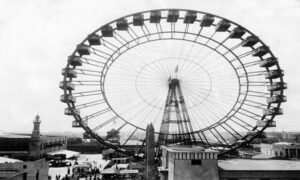Doctor Curmudgeon® It Goes Around and Around and Around…
By Diane Batshaw Eisman, M.D. FAAP Doctor Eisman is in Family Practice in Aventura, Florida with her partner, Dr. Eugene Eisman, an internist/cardiologist
It was a quiet Sunday afternoon on the drive home after enjoying brunch at a friend’s.
This weekend, two of our cousins on the feline side of our family stayed with us while their parents had a much needed second honeymoon.
As we rode along the highway, the two energetic kittens strapped into the back seat squealed with joy and urged us to stop.
Those youngsters are ready for anything that looks dangerous, fast or messy.
This time, they had spied a carnival along the side of the road.
And, of course, it was the towering Ferris wheel that captured their adventurous little eyes.
I began to wonder whose imagination conceived of this insubstantial (to me) looking marvel.
The creator of this scary contraption turned out to be George Washington
Gale Ferris, Jr., a young engineer from Pittsburgh.
The United States Congress of 1890 decreed that there should be a massive celebration honoring the four hundredth anniversary of the discovery of America by Columbus.
An architect, Daniel Burnham found himself in charge of changing a boggy mess of Chicago’s terrain into something that was supposed to dazzle the entire world.
Paris had just created a masterpiece landmark called the Eiffel Tower. And, of course, Burnham was charged with finding something extraordinary to top that famous landmark.
This massive undertaking for the celebration was known as the World’s Columbian Exposition.
Ferris, a graduate of the California Military Academy and Rensseler Polytechnic Institute, had already spent years working in the mining and railroad industries. He was well known professionally for his skill in the testing of structures and materials.
His company had sent him to Chicago to inspect the steel that was being used in various constructions for the fair.
Burnham had been pressured to come up with something that would surpass Paris’ Eiffel Tower. It had to be innovative and unique or else Chicago would be humiliated.
He spoke with a group of engineers urging them to use their creative ability and be daring. After all, Chicago’s reputation was at stake.
It was George Ferris who came up with the brilliant idea of a revolving wheel carrying people high above the Fair grounds. It would be more dazzling and imaginative than the Eiffel Tower.
But when Ferris first presented his plan, Burnham was greatly concerned about the structure with such fragile looking slender rods supporting cars conveying people.
Ferris took up the challenge and wound up spending twenty five thousand dollars of his own money to hire other engineers and do studies on safety.
It was a horrendous task, especially with the country in the throes of a great recession.
Ferris’s engineering skills, concerns with safety and personal enthusiasm finally brought his wheel to fruition.
And so, on June 11, 1893 the wheel turned with its first passengers; Daniel Burnham and Margaret Ferris (her husband was in Pittsburgh at the time) and opened to the public on June 21, 1893.
A reporter, Robert Graves wrote of his experience on the Ferris wheel; “It is an indescribable sensation, of revolving through such a vast orbit in a bird cage.”
Although it was a superb feat of engineering, it had a sad ending. The fair was over, the entrance gates were closed and the remarkable Ferris wheel was sold to the 1904 Louisiana Purchase Exposition in St. Louis and ended its days being turned into scrap by dynamiting.
But George Washington Gale Ferris, Jr. is remembered. His birthday was on February 14 and February 14 is now recognized as National Ferris Wheel Day.
So, the kittens have been promised that on the next Valentine/National Ferris Wheel Day, we would look for a Ferris wheel. Since chocolate is dangerous for cats, they can ride the wheel in celebration (with adult supervision, of course).
Dr. Curmudgeon suggests “Bitter Medicine”, Dr. Eugene Eisman’s story of his experiences–from the humorous to the intense—as a young army doctor serving in the Vietnam War.
Bitter Medicine by Eugene H. Eisman, M.D. –on Amazon
Doctor Curmudgeon® is Diane Batshaw Eisman, M.D., a physician-satirist. This column originally appeared on SERMO, the leading global social network for doctors.
SERMO www.sermo.com
Click Here to Order Boxing Interviews Of A Lifetime By “Bad” Brad Berkwitt


